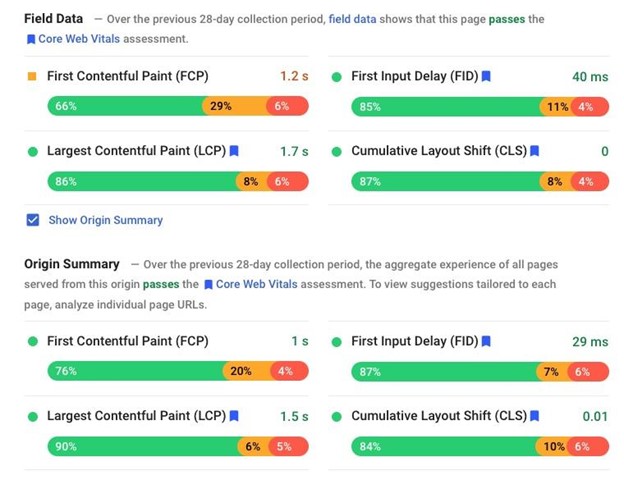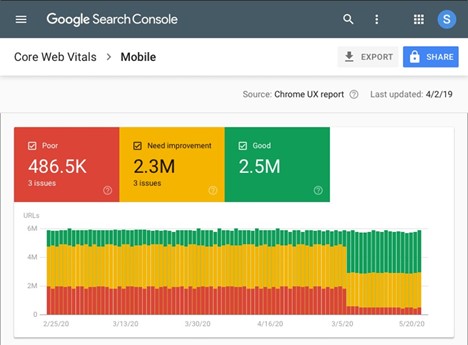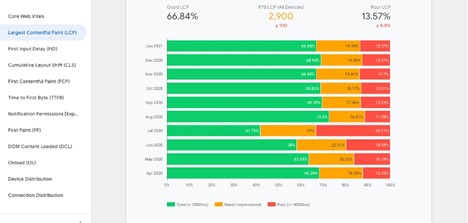By now, you should know that a faster website makes your clients happy, they buy more, and they engage more with your content. However, one client in particular likes fast websites, and that's Google! Fast websites rank higher in organic search results than slower websites. Fast websites will also achieve higher quality scores in Google Adwords, resulting in lower ad spend.
Google has been using them as search signals since May 2021. You might have wondered, though, how will these web vitals be determined? Will the Google Bot gather them? The answer is no; it turns out that Google has another method, and they've been working on it for several years.
Introducing the Chrome UX Report (CRuX)
The CRuX report is a public data set of Real User Measurements (RUM) of website performance across millions of sites. The information has been around since 2017 and is updated daily, but the data has been challenging to access until recently.
The data is collected from real Chrome browser users who have opted to report back to Google information on their browsing. This opt-in requires that the user has:
- Opted in to syncing browser history
- Have bit set up a sync passphrase
- And have usage statistic reporting enabled
Despite these conditions, there are still millions of Chrome users reporting back their statistics to Google. However a given website will have to be fairly busy before there are decent statistics in the report.
Gathered Metrics
Apart from the Web Vitals the report also gathers the following event timings:
- DOMContentLoaded: when the main document has been loaded
- Onload: when a page and all its associated resources have been downloaded and parsed;
Dimensions
As performance can vary widely, the metrics are divided into the following dimensions, to help segment and understand the user experience.
- Country
- Device Type: Tablet, Phone, Desktop
- Connection Speed: slow 2g, 2g, 3g, 4g, or offline
Viewing data in the report
There are several ways of seeing how your website performs in the report. These include:
Pagespeed insights
Google's website analysis tool provides summary CRuX data for the analysed URL and also for the entire site in its results, if data is available.

Google BigQuery
The most flexible way is to directly access it via BigQuery. You use SQL (database query language). The downside is that you have to have an understanding of SQL to use it as well as a Google account.
Google's Search Console (formerly Webmaster Tools)
The search console now has a section 'Core Web Vitals' that provides basic information on whether URLs pass the Core Web Vitals or not as well as a nice historical graph of performance for both mobile and desktop.

Google's Data Studio
Data studio is a data visualisation tool that lets you build dashboards on top of the CrUX report (amongst other big data sources). It enables you to easily create a cool visualisation of the performance of your (or someone elses) website over time.

Third party tools
Like Peakhour's very own competitor speed report! This uses the Chrome UX API to retrieve the information.
TML’s partnership with Peakhour.io
At The Missing Link, we partner with the best and most disruptive vendors in the industry to provide the best Web Acceleration & Cloud-based Cyber Security solutions to our clients. While we provide solutions from many global Cyber Security vendors, we are excited to partner with an Australian Sovereign-owned and operated company like Peakhour, who are driving innovation in the critical cyber defence sector, right here in Australia.
Here's what our CISO, Aaron Bailey, had to say about our new partnership, "We have been providing strategic cyber security advice to our clients for many years, and every customer worries about their vital business assets connected to the internet and at constant risk of cyber attack. Peakhour’s cloud-based cyber defences block attacks near the source, long before the attack traffic gets anywhere near Australia or our clients’ own IT infrastructure. I feel very strongly that this “Defence in Depth” approach - where Peakhour complements our other (on-prem) cyber defences - will deliver a truly secure IT experience for our customers."
When asked for comment about this new partnership, Robert Healey, Head of Sales at Peakhour, had this to say: " We're delighted to be working with The Missing Link as our largest Australian partner. Aaron and the team bring an enviable level of security-focused expertise to the partnership. They immediately understood the business benefits that an integrated, cloud-based cyber defence service can deliver to their customers. Our existing joint customer base clearly shows that there’s a strong appetite to support innovation in Australia and to buy locally wherever the services can deliver world-class results. We look forward to further growth together with The Missing Link."
If you'd like to see how Peakhour can accelerate and protect your online business, contact one of our Cyber Security experts today.
If you liked this article, you may also like:
Leveraging RPA to combat the Great Resignation
How cyber security impacts your SEO strategy



